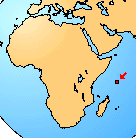Sooglossidae
David Cannatella- Sooglossus gardineri
- Sooglossus sechellensis
- Nesomantis thomasseti
Introduction
Sooglossids include two genera of small frogs that are restricted to the Seychelles islands of the Indian Ocean (Silhouette and Mahé). The frogs are relatively small and terrestrial. Their phylogenetic placement is the subject of much controversy; see below. They are unusual as neobatrachians in having inguinal amplexus. There are no fossils.Geographic Distribution
The distribution of living members of the family Sooglossidae is confined to the Seychelles Islands, as indicated in red.

Discussion of Phylogenetic Relationships
Ford and Cannatella (1993) defined Sooglossidae as a node-based name for the common ancestor of Nesomantis and Sooglossus, and all its descendants. The only published synapomorphy appears to be the presence of a sesamoid bone in the heel region (os sesamoides tarsale; Nussbaum, 1982), a feature shared with some petropedetine ranids. Sooglossids have been allied to ranoids (Griffiths, 1959a, 1963; Tyler, 1985) or to myobatrachids (Lynch, 1973). Duellman (1975) placed the sooglossids with ranoids on the basis of zoogeography. The two derived characters cited as evidence of a ranoid relationship (Griffiths, 1959a) are the semitendinosus tendon passing dorsal to the m. gracilis and partial fusion of the epicoracoid cartilages and sternum of the pectoral girdle. Nussbaum (1980) concluded that placement of Sooglossidae in Ranoidea was not supported, and preferred its placement near myobatrachids. Hay et al. (1995) placed Sooglossus in a trichotomy with 1) ranoids and 2) a clade composed of all other neobatrachians.
Ford and Cannatella (1993) described five shared derived characters allying sooglossids to myobatrachines. The first is a ventrally incomplete cricoid ring (Lynch, 1973); the ring is complete in Rheobatrachus and limnodynastines (Heyer and Liem, 1976). The second is the semitendinosus tendon inserting dorsal to the m. gracilis. This is shared with all myobatrachines except for Taudactylus, which has a ventral insertion (plesiomorphic); the insertion is also ventral in Rheobatrachus (Heyer and Liem, 1976). A third shared derived character is the horizontal pupil, which sooglossids share with myobatrachines, except for Uperoleia (also vertical in Rheobatrachus). Limnodynastines primitively have a vertical pupil, but several genera have horizontal ones (Heyer and Liem, 1976). A fourth derived character shared with myobatrachines and Rheobatrachus is the winglike alary processes of the hyoid (Griffiths, 1959a). The fifth is a divided sphenethmoid, which is present in sooglossids (Griffiths, 1959a) and myobatrachines but not limnodynastines (Lynch, 1971). Ford and Cannatella (1993) concluded that Sooglossidae is the sister taxon of Myobatrachinae (Table 1), and they treated the two as an unnamed more inclusive taxon.
A character of uncertain status is the presence of notochordal vertebrae (Lynch, 1973; but Noble [1926] reported procoelous vertebrae), reported in myobatrachines and sooglossids, but not limnodynastines. The polarity is uncertain because 1) other presumably closely related taxa have not been characterized adequately, and 2) observations on dried specimens differ from those made from serial sections (Cannatella, personal observation). Sooglossids and myobatrachines share the plesiomorphic condition of inguinal amplexus. According to Heyer and Liem (1976), Mixophys is the only myobatrachid genus with axillary amplexus, but Lynch (1973) incorrectly reported that myobatrachines have inguinal amplexus and limnodynastines have axillary amplexus.
References
Click here for general list of references
About This Page
If you are interested in authoring or co-authoring the page for this taxon, or some part of it (even a species), contact David Cannatella.
David Cannatella

University of Texas, Austin, Texas, USA
Correspondence regarding this page should be directed to David Cannatella at
Page copyright © 1995 David Cannatella
 Page: Tree of Life
Sooglossidae.
Authored by
David Cannatella.
The TEXT of this page is licensed under the
Creative Commons Attribution License - Version 3.0. Note that images and other media
featured on this page are each governed by their own license, and they may or may not be available
for reuse. Click on an image or a media link to access the media data window, which provides the
relevant licensing information. For the general terms and conditions of ToL material reuse and
redistribution, please see the Tree of Life Copyright
Policies.
Page: Tree of Life
Sooglossidae.
Authored by
David Cannatella.
The TEXT of this page is licensed under the
Creative Commons Attribution License - Version 3.0. Note that images and other media
featured on this page are each governed by their own license, and they may or may not be available
for reuse. Click on an image or a media link to access the media data window, which provides the
relevant licensing information. For the general terms and conditions of ToL material reuse and
redistribution, please see the Tree of Life Copyright
Policies.
Citing this page:
Cannatella, David. 1995. Sooglossidae. Version 01 January 1995 (under construction). http://tolweb.org/Sooglossidae/16947/1995.01.01 in The Tree of Life Web Project, http://tolweb.org/






 Go to quick links
Go to quick search
Go to navigation for this section of the ToL site
Go to detailed links for the ToL site
Go to quick links
Go to quick search
Go to navigation for this section of the ToL site
Go to detailed links for the ToL site